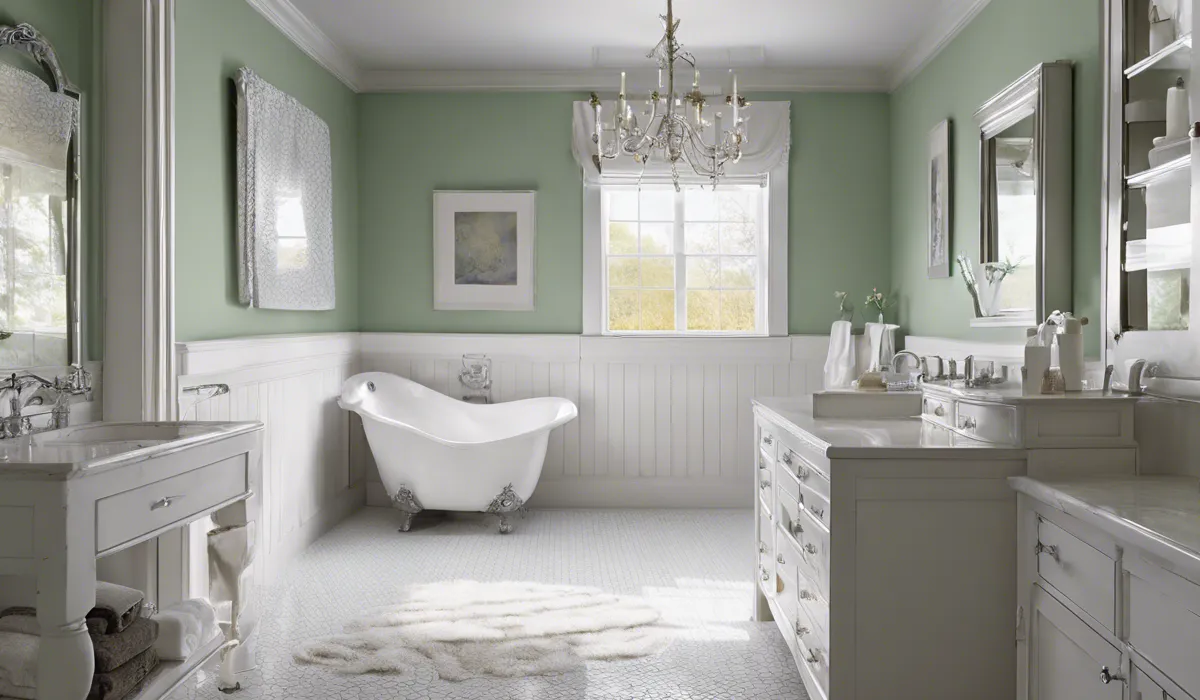Use a semi-gloss or satin-finish latex paint with anti-microbial properties to prevent mold in bathrooms. These paints are moisture-resistant and easy to clean, making them ideal for high-humidity areas.
Bathroom Mold and Paint Choices

Mold Growth in Humid Conditions
Mold thrives in environments that are moist, warm, and poorly ventilated, conditions often found in bathrooms.
The presence of water and steam from showers and baths increases humidity levels, creating an ideal breeding ground for mold spores.
These spores attach to walls and ceilings, especially in corners and near plumbing fixtures, where they can start to grow and spread if not properly managed.
Importance of Mold-Resistant Paint
Choosing the right paint is crucial for preventing mold growth in your bathroom. Paints with mold-inhibiting properties help create a barrier on your walls and ceilings that resists moisture penetration and makes it harder for mold to establish a foothold.
By selecting an appropriate paint, you can not only protect your bathroom surfaces but also ensure a healthier environment for your home.
Overview of Mold-Inhibiting Paints
There are specific paints designed to combat mold growth. These products typically contain anti-microbial agents that actively prevent mold from developing. They come in various finishes, with certain types more suited for bathroom conditions.
Understanding the different paint options available will aid you in making the best choice for your space.
Best Types of Paint for Mold Prevention

High-Gloss and Semi-Gloss Paints
High-gloss and semi-gloss paints are particularly advantageous for bathroom walls due to their moisture resistance and ease of cleaning.
Their shiny surfaces do not allow water to penetrate easily, which prevents mold from growing underneath.
Moreover, these types of paint tend to be more durable and stand up well to frequent scrubbing, ensuring that any mold spores on the surface can be effectively removed.
Ingredients in Mold-Resistant Paints
Mold-resistant paints are formulated with fungicides and other biocides that inhibit mold and mildew growth.
These ingredients disrupt the mold’s life cycle and prevent it from spreading. When applied to bathroom walls and ceilings, these paints create a less hospitable environment for mold, helping to keep your bathroom clean and healthy.
Latex Paints vs. Oil-Based Paints
Latex paints are water-based and are generally preferred for bathroom use. They dry quickly, have less odor, and are easier to clean up than oil-based paints.
Latex paints with a semi-gloss or satin finish are recommended for their mold-resistant qualities.
On the other hand, oil-based paints are more durable and water-resistant but can be more challenging to work with and take longer to dry. They also tend to emit stronger fumes, requiring better ventilation during application and drying.
Practical Tips for Painting Your Bathroom to Prevent Mold

Ensuring Adequate Ventilation
Proper ventilation is a key element in preventing mold growth in bathrooms. During and after painting, make sure to use exhaust fans or open windows to allow moisture to escape.
This will help the paint dry properly and reduce the overall humidity levels in the bathroom, creating a less favorable environment for mold.
Priming Surfaces for Mold Prevention
Using a mold-resistant primer before painting can significantly enhance the anti-microbial efficacy of your paint job.
Primers are designed to create a smooth surface for paint to adhere to and can contain the same anti-microbial ingredients found in mold-resistant paints. This additional layer of protection can be crucial in areas prone to high moisture.
Application Techniques to Minimize Mold Risks
When painting, it’s important to apply paint evenly and allow sufficient drying time between coats.
Good practice includes starting with the ceiling and working your way down to lower wall sections, as this prevents drips and uneven coverage.
Make sure to cover every nook and cranny where mold might hide. Use a brush for the edges and a roller for larger surfaces to ensure a consistent application.
Maintenance After Painting
Regular maintenance is essential to keep mold at bay after painting. This includes frequent cleaning of bathroom surfaces, checking for any signs of moisture accumulation, and repairing leaks promptly.
Use gentle, non-abrasive cleaners to preserve the integrity of the paint and its mold-resistant properties. Reapply caulking as needed to seal any gaps around fixtures like the toilet flange and ensure that the exhaust fan is functioning properly to remove excess humidity.
FAQs About Paint for Bathrooms to Prevent Mold
What type of paint should I use in a bathroom to prevent mold?
Use a semi-gloss or satin-finish latex paint with anti-microbial properties to prevent mold in bathrooms.
Why is semi-gloss or satin-finish paint recommended for bathrooms?
Semi-gloss or satin-finish paints are recommended for bathrooms due to their moisture-resistant and easy-to-clean properties.
Can anti-microbial paint prevent mold growth in high-humidity areas?
Yes, anti-microbial paints can prevent mold growth in high-humidity areas like bathrooms.
Is it necessary to use moisture-resistant paint in a bathroom?
Yes, using moisture-resistant paint in a bathroom is necessary to help prevent mold and mildew.
How do I maintain the paint in my bathroom to keep it mold-free?
Maintain the paint in your bathroom by keeping it clean and ensuring adequate ventilation to reduce moisture levels.
Final Thoughts
To mitigate mold growth in bathrooms, it’s recommended to use latex paint with a semi-gloss or satin finish that includes anti-microbial properties.
These paints offer resistance to moisture and are readily cleanable, which makes them exceptionally suitable for areas with high humidity.
